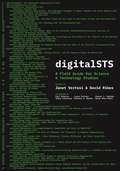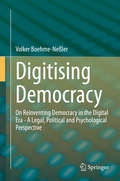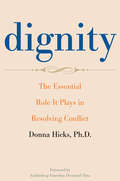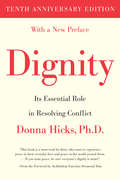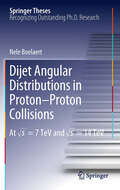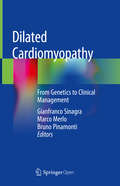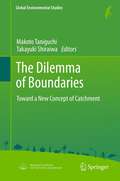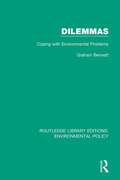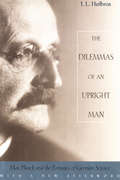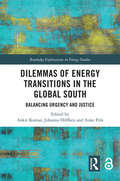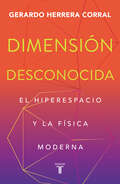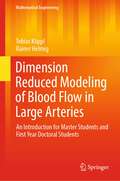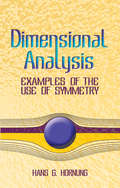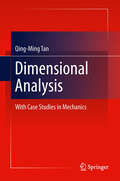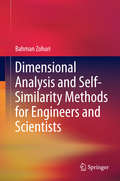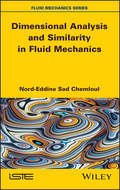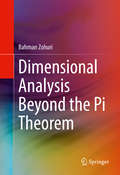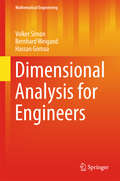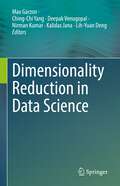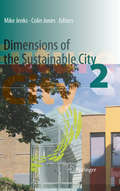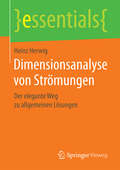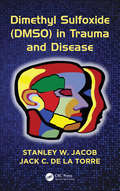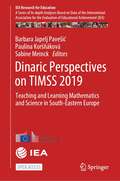- Table View
- List View
digitalSTS: A Field Guide for Science & Technology Studies
by Janet Vertesi David RibesScholars across the humanities, social sciences, and information sciences are grappling with how best to study virtual environments, use computational tools in their research, and engage audiences with their results. Classic work in science and technology studies (STS) has played a central role in how these fields analyze digital technologies, but many of its key examples do not speak to today’s computational realities. This groundbreaking collection brings together a world-class group of contributors to refresh the canon for contemporary digital scholarship.In twenty-five pioneering and incisive essays, this unique digital field guide offers innovative new approaches to digital scholarship, the design of digital tools and objects, and the deployment of critically grounded technologies for analysis and discovery. Contributors cover a broad range of topics, including software development, hackathons, digitized objects, diversity in the tech sector, and distributed scientific collaborations. They discuss methodological considerations of social networks and data analysis, design projects that can translate STS concepts into durable scientific work, and much more.Featuring a concise introduction by Janet Vertesi and David Ribes and accompanied by an interactive microsite, this book provides new perspectives on digital scholarship that will shape the agenda for tomorrow’s generation of STS researchers and practitioners.
Digitising Democracy: On Reinventing Democracy in the Digital Era - A Legal, Political and Psychological Perspective
by Volker Boehme-NeßlerThis book argues that in the digital era, a reinvention of democracy is urgently necessary. It discusses the mounting evidence showing that digitalisation is pushing classical parliamentary democracy to its limits, offering examples such as how living in a filter bubble and debating with political bots is profoundly changing democratic communication, making it more emotional, hysterical even, and less rational. It also explores how classical democracy involves long, slow thinking and decision processes, which don’t fit to the ever-increasing speed of the digital world, and examines the technical developments some fear will lead to governance by algorithms.In the digitalised world, democracy no longer functions as it has in the past. This does not mean waving goodbye to democracy – instead we need to reinvent it. How this could work is the central theme of this book.
Dignity
by Donna HicksThe desire for dignity is universal and powerful. It is a motivating force behind all human interaction--in families, in communities, in the business world, and in relationships at the international level. When dignity is violated, the response is likely to involve aggression, even violence, hatred, and vengeance. On the other hand, when people treat one another with dignity, they become more connected and are able to create more meaningful relationships. Surprisingly, most people have little understanding of dignity, observes Donna Hicks in this important book. She examines the reasons for this gap and offers a new set of strategies for becoming aware of dignity's vital role in our lives and learning to put dignity into practice in everyday life. Drawing on her extensive experience in international conflict resolution and on insights from evolutionary biology, psychology, and neuroscience, the author explains what the elements of dignity are, how to recognize dignity violations, how to respond when we are not treated with dignity, how dignity can restore a broken relationship, why leaders must understand the concept of dignity, and more. Hicks shows that by choosing dignity as a way of life, we open the way to greater peace within ourselves and to a safer and more humane world for all.
Dignity: Its Essential Role in Resolving Conflict
by Donna HicksDrawing on her extensive experience in international conflict resolution and on insights from evolutionary biology, psychology, and neuroscience, Donna Hicks explains what the elements of dignity are, how to recognize dignity violations, how to respond when we are not treated with dignity, how dignity can restore a broken relationship, why leaders must understand the concept of dignity, and more. By choosing dignity as a way of life, Hicks shows, we open the way to greater peace within ourselves and to a safer and more humane world for all. For the Tenth Anniversary Edition of Dignity, Hicks has written a new preface that reflects on her experience helping communities and individuals understand the power of dignity and how it can lead to a more peaceful world. &“Anyone who understands the importance of personal feelings and their fuel for conflict should consider Dignity as a powerful advisory and motivational guide.&”—Midwest Book Review Winner of the 2012 Educator&’s Award, given by the Delta Kappa Gamma Society International.
Dijet Angular Distributions in Proton-Proton Collisions
by Nele BoelaertThis thesis is based on the first data from the Large Hadron Collider (LHC) at CERN. Its theme can be described as the classical Rutherford scattering experiment adapted to the LHC: measurement of scattering angles to search for new physics and substructure. At the LHC, colliding quarks and gluons exit the proton collisions as collimated particle showers, or jets. The thesis presents studies of the scattering angles of these jets. It includes a phenomenological study at the LHC design energy of 14 TeV, where a model of so-called large extra dimensions is used as a benchmark process for the sensitivity to new physics. The experimental result is the first measurement, made in 2010, by ATLAS, operating at the LHC start-up energy of 7 TeV. The result is compatible with the Standard Model and demonstrates how well the physics and the apparatus are understood. The first data is a tiny fraction of what will be accumulated in the coming years, and this study has set the stage for performing these measurements with confidence as the LHC accumulates luminosity and increases its energy, thereby probing smaller length scales.
Dilated Cardiomyopathy: From Genetics to Clinical Management
by Gianfranco Sinagra Marco Merlo Bruno PinamontiThis open access book presents a comprehensive overview of dilated cardiomyopathy, providing readers with practical guidelines for its clinical management. The first part of the book analyzes in detail the disease’s pathophysiology, its diagnostic work up as well as the prognostic stratification, and illustrates the role of genetics and gene-environment interaction. The second part presents current and future treatment options, highlighting the importance of long-term and individualized treatments and follow-up.Furthermore, it discusses open issues, such as the apparent healing phenomenon, the early prognosis of arrhythmic events or the use of genetic testing in clinical practice.Offering a multidisciplinary approach for optimizing the clinical management of DCM, this book is an invaluable aid not only for the clinical cardiologists, but for all physicians involved in the care of this challenging disease.
The Dilemma of Boundaries
by Makoto Taniguchi Takayuki ShiraiwaWater circulates continuously and seamlessly on Earth with little regard for the boundaries we draw. There are natural boundaries as between land and ocean and surface and subsurface environments, as well as human or demographic boundaries between nations, cultures, and religions. Although considered necessary by societies, these human-created boundaries disrupt natural water circulation, leading to serious water-related environmental problems. The dilemma of how to manage water beyond our boundaries remains, and nations have different ways and means of controlling each form of water, whether as vapor, surface water, groundwater, or seawater. Recent findings on the interaction of water from land, oceans, and the atmosphere encourage researchers to undertake collaborative work that goes beyond the boundaries of each discipline, be it oceanography, surface and subsurface hydrology, climatology, or glaciology. Drawing on all these fields, the book focuses on two major boundaries: that between surface water and ground water, and that between terrestrial water and ocean water. This comprehensive work is of great value to experts in academia, international organizations, consulting firms, water resources, fisheries, and urban development planning agencies.
Dilemmas: Coping with Environmental Problems (Routledge Library Editions: Environmental Policy #3)
by Graham BennettFirst published in 1992. Why are environmental problems, problems? Usually, says Graham Bennett. because the interests of the polluter are incompatible with the preservation of the environment. A hunter of whales, no matter how concerned about their decline, will always need to kill again, and a government, no matter how worried about the effects of its polluting industry, will still fight to keep it going. In this fascinating book the author takes six examples as far apart as the Rhine and the Arctic, as Tennessee and the Gulf of Genoa, to illustrate his point. In doing so he shows up the dilemmas facing those who are fighting to improve matters. He demonstrates the degree of duplicity exercised by those in power in order to preserve their interests, but he also shows how often environmental problems emerge simply because of muddle. These riveting stories describe not just the well-known effects of pollution or environmental destruction, but the ways in which the problems arise and the circumstances and complexity of the questions to be resolved. Whatever the concern - the preservation of the Bowhead Whale, or dumping salt in the Rhine - this book is a must for every environmentalist.
The Dilemmas of an Upright Man: Max Planck and the Fortunes of German Science, With a New Afterword
by J. L. HeilbronIn this moving and eloquent portrait, Heilbron describes how the founder of quantum theory rose to the pinnacle of German science. He shows how Planck suffered morally and intellectually as his lifelong habit of service to his country and to physics was confronted by the realities of World War I and the brutalities of the Third Reich.
Dilemmas of Energy Transitions in the Global South: Balancing Urgency and Justice (Routledge Explorations in Energy Studies)
by Ankit Kumar, Johanna Höffken and Auke PolsThis book explores how, in the wake of the Anthropocene, the growing call for urgent decarbonisation and accelerated energy transitions might have unintended consequences for energy poverty, justice and democracy, especially in the global South. Dilemmas of Energy Transitions in the Global South brings together theoretical and empirical contributions focused on rethinking energy transitions conceptually from and for the global South, and highlights issues of justice and inclusivity. It argues that while urgency is critical for energy transitions in a climate-changed world, we must be wary of conflating goals and processes, and enquire what urgency means for due process. Drawing from a range of authors with expertise spanning environmental justice, design theory, ethics of technology, conflict and gender, it examines case studies from countries including Bolivia, Sri Lanka, India, The Gambia and Lebanon in order to expand our understanding of what energy transitions are, and how just energy transitions can be done in different parts of the world. Overall, driven by a postcolonial and decolonial sensibility, this book brings to the fore new concepts and ideas to help balance the demands of justice and urgency, to flag relevant but often overlooked issues, and to provide new pathways forward. This volume will be of great interest to students and scholars of energy transitions, environmental justice, climate change and developing countries.
Dimensión desconocida: El hiperespacio y la física moderna
by Gerardo Herrera CorralUn libro sobre la naturaleza del tiempo y el espacio, y la exploración científica de otras dimensiones. Y si existiera una cuarta dimensión espacial que no pudiéramos percibir? ¿Y si el tiempo, que nos parece una realidad implacable, no fuera más que una ilusión de nuestra mente? ¿Y si nuestro universo fuera sólo uno de los muchos que integran un complejo multiverso inflacionario? Estas preguntas, que parecieran derivadas de un guion de ciencia ficción o propias de un temperamento esotérico, constituyen algunos de los planteamientos más rigurosos de la física moderna. Y son la fascinante materia de este libro.La ciencia lleva más de un siglo explorando el hiperespacio, es decir, considerando la existencia real de un espacio con cuatro o más dimensiones. En Dimensión desconocida, Gerardo Herrera Corral revisa los momentos más importantes de esa aventura, tanto teórica como experimental: desde la fusión del tiempo y el espacio en una sola entidad —por parte de teoría de la relatividad—, pasando por la primera propuesta de una dimensión adicional —en un intento por unificar la gravedad y el electromagnetismo—,hasta llegar a las 26 dimensiones que postula la teoría de cuerdas, que luego serían reducidas a 10, debido a la supersimetría. Quizás esas otras dimensiones son demasiado grandes o demasiado pequeñas y por ello no hemos podido detectarlas. Sin embargo, si llegara a comprobarse su existencia, cambiaría para siempre nuestra noción de la realidad, pues, como nos recuerda Herrera Corral, el tiempo y el espacio son más que el simple escenario
Dimension Reduced Modeling of Blood Flow in Large Arteries: An Introduction for Master Students and First Year Doctoral Students (Mathematical Engineering)
by Tobias Köppl Rainer HelmigThis monograph contains an in-depth and coherent treatment of dimension-reduced modeling of blood flows on the level of large vessels (macrocirculation). The authors reduce the complexity by combining a one-dimensional Navier-Stokes equation and a simplified FSI-concept. The influence of omitted vessels, which are subsequent to the outlets of larger vessels, is accounted for by systems of ordinary differential equations (0D models). The target audience primarily comprises research experts in the field of biomedical engineering, but the book may also be beneficial for graduate students alike.
Dimensional Analysis: Examples of the Use of Symmetry
by Hans G. HornungDerived from a course in fluid mechanics, this text for advanced undergraduates and beginning graduate students employs symmetry arguments to demonstrate the principles of dimensional analysis. The examples provided illustrate the effectiveness of symmetry arguments in obtaining the mathematical form of the functions yielded by dimensional analysis. Students will find these methods applicable to a wide field of interests.After discussing several examples of method, the text examines pipe flow, material properties, gasdynamical examples, body in nonuniform flow, and turbulent flow. Additional topics include waves on a free liquid surface, examples with other fluid properties, and ideal gas equations of state. Figures appear throughout the text, which concludes with a bibliography.
Dimensional Analysis
by Qing-Ming TanDimensional analysis is an essential scientific method and a powerful tool for solving problems in physics and engineering. This book starts by introducing the Pi Theorem, which is the theoretical foundation of dimensional analysis. It also provides ample and detailed examples of how dimensional analysis is applied to solving problems in various branches of mechanics. The book covers the extensive findings on explosion mechanics and impact dynamics contributed by the author's research group over the past forty years at the Chinese Academy of Sciences. The book is intended for research scientists and engineers working in the fields of physics and engineering, as well as graduate students and advanced undergraduates of the related fields. Qing-Ming Tan is a former Professor at the Institute of Mechanics, the Chinese Academy of Sciences, China.
Dimensional Analysis and Self-Similarity Methods for Engineers and Scientists
by Bahman ZohuriThis ground-breaking reference provides an overview of key concepts in dimensional analysis, and then pushes well beyond traditional applications in fluid mechanics to demonstrate how powerful this tool can be in solving complex problems across many diverse fields. Of particular interest is the book's coverage of dimensional analysis and self-similarity methods in nuclear and energy engineering. Numerous practical examples of dimensional problems are presented throughout, allowing readers to link the book's theoretical explanations and step-by-step mathematical solutions to practical implementations.
Dimensional Analysis and Similarity in Fluid Mechanics
by Nord-Eddine Sad ChemloulDimensional analysis is the basis for the determination of laws that allow the experimental results obtained on a model to be transposed to the fluid system at full scale (a prototype). The similarity in fluid mechanics then allows for better redefinition of the analysis by removing dimensionless elements. This book deals with these two tools, with a focus on the Rayleigh method and the Vaschy-Buckingham method. It deals with the homogeneity of the equations and the conversion between the systems of units SI and CGS, and presents the dimensional analysis approach, before addressing the similarity of flows. Dimensional Analysis and Similarity in Fluid Mechanics proposes a scale model and presents numerous exercises combining these two methods. It is accessible to students from their first year of a bachelor's degree.
Dimensional Analysis Beyond the Pi Theorem
by Bahman ZohuriDimensional Analysis and Physical Similarity are well understood subjects, and the general concepts of dynamical similarity are explained in this book. Our exposition is essentially different from those available in the literature, although it follows the general ideas known as Pi Theorem. There are many excellent books that one can refer to; however, dimensional analysis goes beyond Pi theorem, which is also known as Buckingham's Pi Theorem. Many techniques via self-similar solutions can bound solutions to problems that seem intractable. A time-developing phenomenon is called self-similar if the spatial distributions of its properties at different points in time can be obtained from one another by a similarity transformation, and identifying one of the independent variables as time. However, this is where Dimensional Analysis goes beyond Pi Theorem into self-similarity, which has represented progress for researchers. In recent years there has been a surge of interest in self-similar solutions of the First and Second kind. Such solutions are not newly discovered; they have been identified and named by Zel'dovich, a famous Russian Mathematician in 1956. They have been used in the context of a variety of problems, such as shock waves in gas dynamics, and filtration through elasto-plastic materials. Self-Similarity has simplified computations and the representation of the properties of phenomena under investigation. It handles experimental data, reduces what would be a random cloud of empirical points to lie on a single curve or surface, and constructs procedures that are self-similar. Variables can be specifically chosen for the calculations.
Dimensional Analysis for Engineers
by Volker Simon Bernhard Weigand Hassan GomaaThis monograph provides the fundamentals of dimensional analysis and illustrates the method by numerous examples for a wide spectrum of applications in engineering. The book covers thoroughly the fundamental definitions and the Buckingham theorem, as well as the choice of the system of basic units. The authors also include a presentation of model theory and similarity solutions. The target audience primarily comprises researchers and practitioners but the book may also be suitable as a textbook at university level.
Dimensionality Reduction in Data Science
by Max Garzon Ching-Chi Yang Deepak Venugopal Nirman Kumar Kalidas Jana Lih-Yuan DengThis book provides a practical and fairly comprehensive review of Data Science through the lens of dimensionality reduction, as well as hands-on techniques to tackle problems with data collected in the real world. State-of-the-art results and solutions from statistics, computer science and mathematics are explained from the point of view of a practitioner in any domain science, such as biology, cyber security, chemistry, sports science and many others. Quantitative and qualitative assessment methods are described to implement and validate the solutions back in the real world where the problems originated.The ability to generate, gather and store volumes of data in the order of tera- and exo bytes daily has far outpaced our ability to derive useful information with available computational resources for many domains.This book focuses on data science and problem definition, data cleansing, feature selection and extraction, statistical, geometric, information-theoretic, biomolecular and machine learning methods for dimensionality reduction of big datasets and problem solving, as well as a comparative assessment of solutions in a real-world setting.This book targets professionals working within related fields with an undergraduate degree in any science area, particularly quantitative. Readers should be able to follow examples in this book that introduce each method or technique. These motivating examples are followed by precise definitions of the technical concepts required and presentation of the results in general situations. These concepts require a degree of abstraction that can be followed by re-interpreting concepts like in the original example(s). Finally, each section closes with solutions to the original problem(s) afforded by these techniques, perhaps in various ways to compare and contrast dis/advantages to other solutions.
The Dimensions of Federalism: State Governments and Pollution Control Policies
by William R. LowryThe resurgence of state involvement in policymaking in recent years has renewed a long-standing debate about the most effective role for states within a federal system of government. In The Dimensions of Federalism, William R. Lowry assesses and examines the responsiveness and innovation of state governments in the area of air and water pollution control policies. Building a theoretical model that demonstrates the relationship between state and federal governments, Lowry combines econometric analysis of data on all fifty states with an in-depth study of a leading state in each of four major areas of pollution policy to conclude that state policymakers will often experiment and willingly improve upon federal pollution control standards. But this willingness is tempered, he maintains, both by a fear of losing important constituents to interstate competition and by the difficulty of coordinating efforts and disseminating information without the active involvement of the federal government. Originally published in 1992, this book continues to be pertinent in a political climate that will inevitably see an increased role for states in domestic policymaking. It will be of great interest to students and scholars of American public policy, federalism, and environmental politics and policy.
Dimensions of the Sustainable City
by Mike Jenks Colin JonesThe CityForm consortium's latest book, Dimensions of the Sustainable City, is the first book to report on an empirical multi-disciplinary study specifically designed to address urban sustainability. Drawing together the various dimensions of sustainability - economic, social, transport, energy and ecological - the book examines their relationships both to each other and to urban form. The book investigates the sustainability dimensions of cities through a series of projects based on a common list of elements of urban form, and which draw on the consortium's latest research to review the sustainability issues of each dimension. The elements of urban form include density, land use, location, accessibility, transport infrastructure and characteristics of the built environment. The book also addresses issues such as adapting cities, psychological and ecological benefits of green space and sustainable lifestyles, each presenting a critical review of the relevant literature followed by an empirical analysis presenting the key results. Based on studies across five UK cities, the book draws out findings of relevance to sustainable cities worldwide. As well as an invaluable reference to researchers in sustainable planning and urban design, the book will provide a useful text for advanced undergraduate and graduate courses and for policy makers dealing with these issues. The CityForm consortium is a multi-disciplinary group of researchers from five universities funded by the UK Engineering and Physical Science Research Council from 2003-07.
Dimensionsanalyse von Strömungen: Der elegante Weg zu allgemeinen Lösungen (essentials)
by Heinz HerwigHeinz Herwig zeigt die Bedeutung der Dimensionsanalyse anhand der Strömungsmechanik und der Wärmeübertragung und eröffnet damit eine neue Sichtweise auf die Behandlung technischer Fragestellungen. Mithilfe der Dimensionsanalyse gelingt es, Problemlösungen in dimensionsloser Form und damit bis zu einem bestimmten Grad allgemeingültig zu ermitteln. Wie dies geschehen kann, erschließt sich neuen Nutzern jedoch oftmals nicht auf Anhieb. Nur so ist es zu erklären, dass immer wieder „überraschende Aussagen“ und „unerwartete“ oder auch „offensichtlich widersprüchliche“ Ergebnisse auftauchen. Dieses essential erläutert den physikalischen Hintergrund, den Bezug der Dimensionsanalyse zur Modellbildung sowie die systematische Einordnung verschiedener Aspekte. Ebenfalls gibt es viele praktische Beispiele zur Anwendung.
Dimethyl Sulfoxide (DMSO) in Trauma and Disease
by Stanley W. Jacob Jack C. de la TorreFirst isolated as a chemical compound by a Russian chemist in 1866, dimethyl sulfoxide (DMSO) proved to be a near-perfect solvent for decades before its remarkable biological and medical activities were discovered. DMSO is one of the most prodigious agents ever to come out of the world of drug development. Its wide range of biological actions invol
Dinaric Perspectives on TIMSS 2019: Teaching and Learning Mathematics and Science in South-Eastern Europe (IEA Research for Education #13)
by Barbara Japelj Pavešić Paulína Koršňáková Sabine MeinckThis open access book brings together national experts from across the Dinaric region to rigorously review IEA’s Trends in International Mathematics and Science Study (TIMSS) 2019 grade four data to develop a multidimensional and culturally sensitive perspective on their TIMSS 2019 primary-level results. The Dinaric region, named after the Dinaric Alps, is located in South-eastern Europe, and stretches through Croatia, Bosnia and Herzegovina, Serbia, Montenegro, Kosovo[1], Albania, and North Macedonia. IEA’s TIMSS has been an invaluable resource for monitoring international trends in mathematics and science achievement at grades four and eight since 1995. The TIMSS 2019 administration of the test to grade four students, provided a unique opportunity for analysis within shared regional settings and enabled the construction of this first report based on international study results from the region, prepared by the National Research Coordinators in collaboration with IEA. [1] This designation is without prejudice to positions on status and is in line with UNSCR 1244/1999 and the ICJ Opinion on the Kosovo declaration of independence.
Dingos (Australian Animal Discovery Library)
by Lynn M. StoneFrom the book Jacket: Describes the physical characteristics, behavior, natural habitat, and relationship to humans of the Australian wild dog known as the dingo THE AUSTRALIAN ANIMAL LIBRARY Discover six of the weird and wonderful animals of Australia, the island continent "down under." Read about their curious habits, their conflicts with peoplt and their future. Crocodiles Dingoes Kangaroos Koalas Tasmanian Devils Wombats
